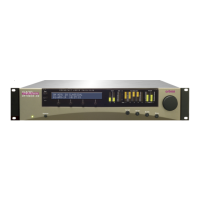3-8
OPERATION ORBAN MODEL 9400
In LW and MW, the audio processor set-up controls are usually used to match the
processor’s ”sound” to a certain type of music or talk programming. HF is different.
In HF, the audio processor is usually adjusted to provide a sound at the receiver that
is as esthetically satisfying as possible, given the probable signal quality at the re-
ceiver. The broadcasting organization usually does not have the luxury of making
fine adjustments to match different types of program material because such fine ad-
justments will almost certainly be masked by the variability of the propagation and
interference experienced by the listener. This fact considerably simplifies the adjust-
ment procedure.
We have tuned the 9400’s “HF” presets with these compromises in mind. There is a
general-purpose preset and a preset tuned to optimize voice intelligibility. We be-
lieve that further subtleties are inappropriate for the medium.
Working Together
Best results will be achiev
ed if Engineering, Programming, and Management go out
of their way to communicate and cooperate with each other. It is important that
Engineering understands well the sound that Programming desires, and that Man-
agement fully understands the trade-offs involved in optimizing certain parameters
(such as loudness and coverage) at the cost of others (such as brightness or distor-
tion).
Processing for Low Bitrate Codecs and HD Radio
The most common bit rate in the iBiquity HD Radio AM system is 36 kbps, while the
bit rate in the Digital Radio Mondiale (DRM) system varies according to transmission
mode but is also low. HD AM uses the HDC codec, while DRM uses the aacPlus
(MPEG HE-AAC) codec. Both codecs employ Coding Technology’s Spectral Band Rep-
lication technology. Codecs with SBR transmit only lower frequencies (for example,
below 8 kHz) via the codec. The decoder at the receiver creates higher frequencies
from the lower frequencies by a process similar to that used by “psychoacoustic ex-
citers.”
36 kbps is a very low bit rate to achieve entertainment-quality stereo audio, even
with an advanced codec like HDC. To maximize audio quality, the 9400 uses look-
ahead limiting for the final peak limiting of the digital processing chain. Unlike clip-
ping, look-ahead limiting does not add significant spectral contamination to the au-
dio. It is therefore much more appropriate than clipping for protecting chains that
include lossy codecs because clipping would otherwise force the codec to waste bits
by trying to encode clipping products.
The appropriate equalization and multiband compression for analog AM are very
different from those appropriate for HD AM or similar channels using lossy codecs.
The equalizer in the analog AM processing chain is usually set to pre-process for the
limitations of conventional AM radios, while the five-band compressor is generally
operated with medium or faster release times to increase program density, maximiz-
ing loudness and coverage. By contrast, the HD AM channel uses no pre-emphasis,
has no limitations on low frequency response, and has high frequency response to
15 kHz. However, the codec does not respond well to very dense material.

